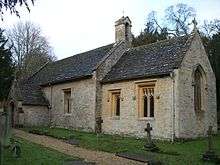Cornwell, Oxfordshire
| Cornwell | |
|---|---|
|
Cornwell village | |
 Cornwell Cornwell shown within Oxfordshire | |
| Population | 66 (2001 Census) |
| OS grid reference | SP2727 |
| Civil parish |
|
| District | |
| Shire county | |
| Region | |
| Country | England |
| Sovereign state | United Kingdom |
| Post town | Chipping Norton |
| Postcode district | OX7 |
| Dialling code | 01608 |
| Police | Thames Valley |
| Fire | Oxfordshire |
| Ambulance | South Central |
| EU Parliament | South East England |
| UK Parliament | |
Cornwell is a village and civil parish about 2.5 miles (4 km) west of Chipping Norton in West Oxfordshire. The 2001 Census recorded the parish's population as 66.[1]
Manor
The manor house dates from the 16th or 17th century, with a dining room and library panelled in about 1640[2] and 17th century stables and dovecote.[3] It was the home of Sir Thomas Penyston, 1st Baronet and his family occupied the house until the 19th century. A new front was built onto the house in about 1750, and the drawing room has a fireplace in the style of Robert Adam.[2] In 1939 the architect Clough Williams-Ellis, who had designed Portmeirion in north Wales, restored the house, added a ballroom and laid out the gardens.[4] The house is a Grade II* listed building.[5]
Parish church

The Church of England parish church of Saint Peter was originally Norman, and the chancel arch survives from this time.[6] Most of the windows are Decorated Gothic and Perpendicular Gothic additions.[2] The church was rebuilt in 1830 and 1882, when the present west window was added.[6] The south door has a porch with a sundial.[7]
The church is a Grade II* listed building.[8]
The church is part of the parish of Little Compton, along with the churches of Chastleton, Daylesford and Little Rollright. The parish is part of the Team Benefice of Chipping Norton, along with the parishes of Chipping Norton with Over Norton, Churchill and Kingham.[9]
Economic and social history
Some of the cottages in the village are 17th century.[3] In 1939 Williams-Ellis remodelled all the cottages in Cornwell and remodelled the former village school in neo-Georgian style as the village hall.[3]
References
- ↑ "Area selected: West Oxfordshire (Non-Metropolitan District)". Neighbourhood Statistics: Full Dataset View. Office for National Statistics. Retrieved 24 March 2010.
- 1 2 3 Sherwood & Pevsner 1974, p. 556.
- 1 2 3 Sherwood & Pevsner 1974, p. 557.
- ↑ Sherwood & Pevsner 1974, p. 556–557.
- ↑ Historic England. "Cornwell Manor (Grade II*) (1198747)". National Heritage List for England. Retrieved 15 February 2015.
- 1 2 Sherwood & Pevsner 1974, pp. 555–556.
- ↑ "Cornwell". Oxfordshire Churches & Chapels. Brian Curtis.
- ↑ Historic England. "Church of St Peter (Grade II*) (1283726)". National Heritage List for England. Retrieved 15 February 2015.
- ↑ Archbishops' Council (2015). "Benefice of Chipping Norton". A Church Near You. Church of England. Retrieved 15 February 2015.
Sources
- Sherwood, Jennifer; Pevsner, Nikolaus (1974). Oxfordshire. The Buildings of England. Harmondsworth: Penguin Books. pp. 555–557. ISBN 0-14-071045-0.
External links
| Wikimedia Commons has media related to Cornwell, Oxfordshire. |
